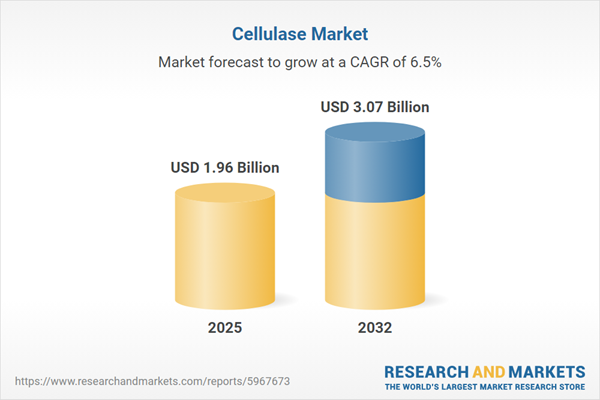Speak directly to the analyst to clarify any post sales queries you may have.
The cellulase market is experiencing rapid transformation, driven by advances in enzyme engineering, heightened demand for sustainable processes, and evolving supply chain strategies. For senior leaders, an in-depth grasp of this sector is crucial to unlocking growth, competitive advantage, and cost efficiency in increasingly regulated and innovation-led global industries.
Market Snapshot: Cellulase Market Size, Growth, and Outlook
The Cellulase Market grew from USD 1.85 billion in 2024 to USD 1.96 billion in 2025. It is expected to continue growing at a CAGR of 6.53%, reaching USD 3.07 billion by 2032. The consistent expansion is underpinned by increasing demand for environmentally compatible solutions and the diversification of enzyme applications across sectors such as biofuels, food and beverage, textiles, pulp and paper, and animal feed. This growth trajectory highlights the sector’s centrality in supporting industrial decarbonization and sustainable product development.
Scope & Segmentation of the Cellulase Market
This analysis delivers an integrated view of the market, encompassing a diverse range of segments, technological advances, and application landscapes necessary for informed, actionable strategies. The research covers the following market segments and regions:
- Source: Actinobacteria (including Amycolatopsis, Streptomyces), Animal-Origin Enzymes (from invertebrates and mammals), Bacteria (such as Bacillus, Cellulomonas), Fungi (notably Aspergillus, Penicillum, Trichoderma reesei), Plant-Origin Enzymes (dicotyledons, monocotyledons).
- Product Type: Liquid Enzymes (high viscosity, low viscosity), Solid Enzymes (granular, powder).
- Application: Agricultural Feed (animal feed, aquaculture), Biofuels (biogas conversion, ethanol production), Food and Beverages (bakery products, brewing, juice extraction), Pulp and Paper (deinking, mechanical pulping), Textiles (cotton processing, denim finishing, fabric care).
- Geography: Americas (United States, Canada, Mexico, Brazil, Argentina, Chile, Colombia, Peru), Europe, Middle East & Africa (including United Kingdom, Germany, France, Russia, Italy, Spain, Netherlands, Sweden, Poland, Switzerland, United Arab Emirates, Saudi Arabia, Qatar, Turkey, Israel, South Africa, Nigeria, Egypt, Kenya), Asia-Pacific (China, India, Japan, Australia, South Korea, Indonesia, Thailand, Malaysia, Singapore, Taiwan).
- Key Players: AB Enzymes GmbH, ABH Biochem Pvt Ltd, Advanced Enzyme Technologies Limited, Amano Enzyme Inc., Aumgene Biosciences Pvt. Ltd., BASF SE, BIO-CAT Inc., Biocatalysts Ltd. by BRAIN Biotech AG, Creative Enzymes, DuPont de Nemours Inc., Dyadic International Inc, ENMEX by Kerry Group plc, and others.
Key Takeaways for Senior Decision-Makers
- Technological breakthroughs in protein engineering and computational modeling are producing enzymes with targeted stability and substrate specificity, opening new opportunities in high-intensity and specialty industrial processes.
- Regulatory pressures and sustainability initiatives are accelerating enzyme adoption, particularly in markets aiming to reduce both chemical usage and carbon emissions in manufacturing and resource processing.
- The market reveals segment-specific performance attributes, such as specific thermal and pH operating ranges for enzymes based on microbial or plant origins, addressing unique sector requirements.
- Collaborations between established conglomerates and biotech innovators are enabling the scaling of custom enzyme solutions, reshaping market entry and supply strategies across regions.
- Strategic supply chain adaptation, highlighted by increasing regional manufacturing and sourcing diversification, is essential to mitigate emerging risks related to tariffs and logistics disruptions.
Tariff Impact: U.S. Measures and Global Supply Chains
Forthcoming United States tariffs on biocatalyst feedstocks are expected to increase raw material costs for cellulase manufacturers relying on imports. This will likely shift contract negotiation dynamics and prompt investment in local production facilities. End users, such as textile and pulp and paper operations, may see pressure on input costs, encouraging a move toward more efficient enzyme blends and exploring vertical integration or localized sourcing to minimize tariff risks.
Methodology & Data Sources
This report utilizes a multi-layered research methodology combining secondary and primary data, expert interviews, and thorough triangulation to deliver robust market insights. Stakeholder validation and rigorous review processes ensure that findings are accurate, current, and actionable for strategic planning.
Why This Report Matters
- Enables executives to build business cases for investment and expansion by identifying key drivers behind enzyme innovation and adoption.
- Guides sourcing and development teams through complex supply dynamics, tariff risks, and regional market intricacies.
- Provides a basis for scenario planning aligned with regulatory changes, partnership strategies, and evolving sustainability objectives.
Conclusion
The cellulase market’s trajectory underscores the critical role of adaptable, sustainable solutions in modern manufacturing and resource industries. Leaders leveraging these insights will be poised to capture value from emerging growth opportunities and shifting global trade dynamics.
Additional Product Information:
- Purchase of this report includes 1 year online access with quarterly updates.
- This report can be updated on request. Please contact our Customer Experience team using the Ask a Question widget on our website.
Table of Contents
3. Executive Summary
4. Market Overview
7. Cumulative Impact of Artificial Intelligence 2025
Companies Mentioned
The companies profiled in this Cellulase market report include:- AB Enzymes GmbH
- ABH Biochem Pvt Ltd
- Advanced Enzyme Technologies Limited
- Amano Enzyme Inc.
- Aumgene Biosciences Pvt. Ltd.
- BASF SE
- BIO-CAT, Inc.
- Biocatalysts Ltd. by BRAIN Biotech AG
- Creative Enzymes
- DuPont de Nemours, Inc.
- Dyadic International Inc
- ENMEX by Kerry Group plc
- Hunan Lerkam Biology Co., Ltd.
- Jiangsu Boli Bioproducts Co., Ltd.
- Kemin Industries, Inc.
- Koninklijke DSM N.V.
- Maps Enzymes Limited
- Megazyme by Neogen Corporation
- Merck KGaA
- Mitsubishi Chemical Corporation
- Novozymes A/S
- Sunson Industry Group Co., Ltd.
- The Archer-Daniels-Midland Company
- VTR Bio-Tech Co., Ltd.
Table Information
| Report Attribute | Details |
|---|---|
| No. of Pages | 190 |
| Published | November 2025 |
| Forecast Period | 2025 - 2032 |
| Estimated Market Value ( USD | $ 1.96 Billion |
| Forecasted Market Value ( USD | $ 3.07 Billion |
| Compound Annual Growth Rate | 6.5% |
| Regions Covered | Global |
| No. of Companies Mentioned | 25 |









